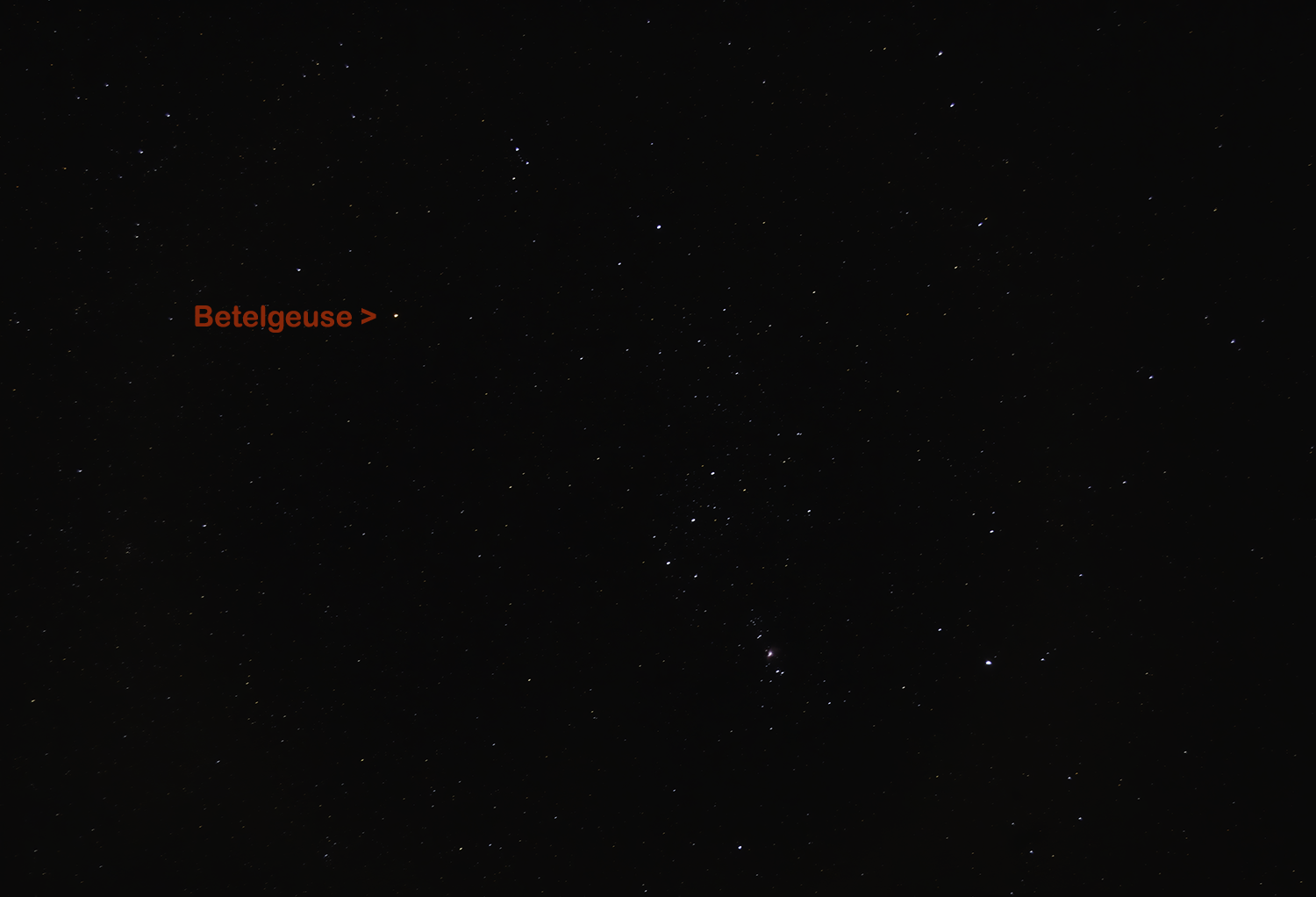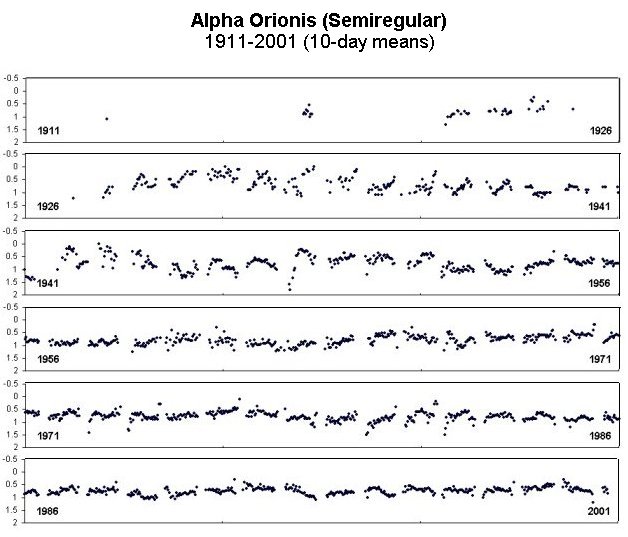When I’m doing my planetarium shows, the children really love the fact that Betelgeuse is so huge if it were in the same position as our Sun, it would swallow many of the inner planets, including Earth, Mars and almost Jupiter.
For more details of my exciting school visits, click here:
https://www.star-gazing.co.uk/WebPage/school_visits.
However, Betelgeuse has recently been attracting attention due to its behaviour. This has bought to the attention of the public that celestial objects aren’t quite as constant as they appear at first glance, but do change. Sometimes sometimes quite quickly and dramatically.
Many social media feeds are buzzing with excitement.
See my original post about this by clicking the link below:
https://www.star-gazing.co.uk/WebPage/betelgeuse-fades
Yes, this bright super red giant naked eye star has dimmed in brightness, but we have known for years that it does do this on a fairly regular basis. It is a variable star.
What makes this a little bit more intriguing is that it hasn’t been quite this dim for more than 40 years.
On the 20th of December 2019, the weather finally allowed me a chance to have a quick look at Orion and try and work out roughly how bright it actually was.
Here’s my image with Betelgeuse marked. It is the bright star in the right shoulder (left hand as seen from Earth) of the constellation of Orion, the Hunter.

Betelgeuse was definitely fainter than Rigel.
I would say that it was on par, or even slightly fainter than Aldebaran in Taurus.
So I guess this makes the magnitude of Betelgeuse that evening about +1.0.
Betelgeuse is normally brighter at about +0.4. So this marks quite a significant drop in brightness.
I did notice that the nearby star Procyon, in Canis Minor, at magnitude +0.3 was also brighter than Betelgeuse.
Having been looking up and admiring Orion since a child, the Hunter did indeed look distinctly different, just from standing in the garden staring at it. Or was it just interpretation and expectations from the knowledge I had?
Being a known variable star, observers have been monitoring the brightness of Betelgeuse for years.
The light curve below has been published by the AAVSO:
https://www.aavso.org/vsots_alphaori

Betelgeuse is at the very end of its life, and if you listen to Brian Cox, you will know that it due to end its life in a supernova event, where it will literally tear itself apart when the stars fuel has run out and it can no longer support its own weight. It will collapse onto itself, the resounding “bounce-back” resulting in a brilliant “explosion” of light.
Is this fading of the star a prequel to the supernova event?
When is it likely to happen?
Are we really likely to see Betelgeuse brighten dramatically very soon?
To be perfectly frank, astronomers really do not really know.
It could be tomorrow, or it could be in 50,000 or even 100,000 years time.
So the statistical likelihood of this event occurring during your ~90 (give or a take a few years) year lifetime is extremely small.
The last supernova that we viewed from fairly close quarters was in 1987.
This was a naked eye supernova called 1987A, but was only visible from the southern hemisphere.
That supernova was located in the Large Magellanic Cloud and lies around 168,000 light years away from Earth.
Betelgeuse is only about 700 light years away, so is a lot closer.
If it did go supernova, it would appear much, much brighter in our sky.
If it did “pop” today, the speed of light dictates that it would take another 700 years before we see the supernova.
But, let’s suppose Betelgeuse actually went supernova just over 699 years ago.
If that is the case, the light is already well on its way and could reach us within the next year.
When the event happens, we will witness Betelgeuse brighten enormously, and extremely quickly.
At its brightest it would be as bright as the Full Moon.
All that light will be contained within a minuscule point of light, making Orion looking very strange indeed.
Betelgeuse would be a fantastically brilliant star in Orion’s right shoulder, making astronomical observations very difficult for a number of months. The bright light will make the sky background extremely bright when above the horizon, blotting out many fainter objects.
The supernova will be so bright, that it will be visible during the day.
After many weeks outshining all the other stars in the sky, the supernova’s light will start to fade.
Over time the light will fade so much, it will drop below naked eye visibility.
From then on our view of Orion will change forever, The Mighty Hunter effectively will effectively lose his right shoulder as we will now longer be able to see Betelgeuse with the naked eye.
But what a legacy Betelgeuse will leave behind. The fading supernova and its remnant should keep astronomers busy for many, many years to come as they observe the repercussions of the stars demise and the expanding shock-wave and cloud of debris emanating from the position of this ex-star.
But Hey! Don’t hold your breath waiting for it to happen!
But wouldn’t it be fantastic if it did?
We just love all the intrigue and speculation.
That’s what makes this wonderful hobby so fantastic.

Dave, I have been wondering about one thing and could not find an answer in the web. Betelgeuse has 10-20 times the mass of the sun, yet its radius would reach Jupiter’s orbit. This means that Betelgeuse’s density — about 1.1 * 10exp(-8) that of the Sun. Yet it is apparently busy fusing lighter elements into heavier ones. How is this possible at such low density? Does it have a small dense core about 10 times that of the Sun and a cloud of hot gas surrounding it? If so, how does the cloud remain hot and not fall back into the core?
Ok, I found an answer. Apparently Betelgeuse is only 4,5 times the size of the Sun in diameter. What many incorrectly refer to as the giant start that would extend to Jupiter’s orbit is actually a cloud of hot gas — a nebula — that has formed when Betelgeuse has spewed out its outer layers. What (almost) everyone seems to refer to as a ‘giant start’ is actually a cloud of hot gas, and the actual start is much, much smaller. Apparently the reference to an impressive size is so attractive that many are willing to overlook this small detail. To me, a star 4,5 times the Sun is still impressive, surrounded by a nebula or not.